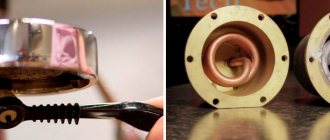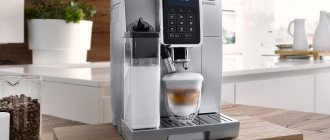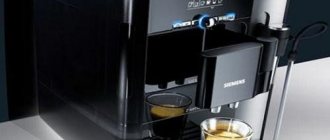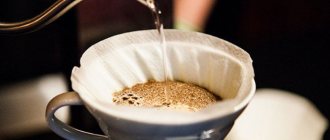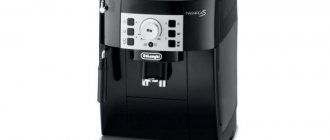Methods for eliminating scale
Citric acid is the active ingredient in descaling products.
Acids react with salts (scale) and convert hardened deposits into a soluble form. Cleaning methods are based on this.
Depending on the degree of salt contamination, determine how much citric acid is needed to clean the kettle:
Photo Description
For slight precipitation and for prevention
For one-time use – 50 g sachet or 2 tbsp. spoons without a slide.
The price of such a descaler is about 20 rubles.
With multilayer sediment
You will need 2 bags of 50 g each.
For initial cleaning – 1 pc., for reuse – 1 pc.
Do not exceed the amount of powder, otherwise you risk damaging the inner surface of the cookware.
Method 1: universal
Main stages: preparing the solution, boiling, washing off the sediment.
I offer the most effective and economical way to remove scale from a kettle using citric acid. Suitable for enameled, glass and stainless steel cookware:
PhotoSequence
Step 1
Make a citric acid solution:
- Pour the contents of the sachet into cold water (40-50 g per 1 liter of water).
- Stir thoroughly until the granules dissolve.
Step 2
Boil the solution:
- Pour the acidic liquid into the bowl.
- Next, you need to boil the kettle for 5 minutes.
- If you are cleaning an electrical appliance, after turning it off, turn it on again after 3 minutes.
Step 3
Wait for the boiling water to cool and pour it out.
Inspect the surface: if plaque remains, remove it with your own hands - rub with a dish sponge. This will remove the softened sediment.
Step 4
Thorough dishwashing:
- Rinse at least three times under running water.
- Pour water into the kettle and boil again.
- Pour boiling water and the acidic liquid is completely washed out.
Method 2: gentle cleaning
The safest option for removing scale from a kettle with a plastic or glass surface is to use lemon. With this high acid content fruit, you can easily remove salt and lime deposits from your dishes and add shine to them:
PhotoInstructions
Preparation
Cut the lemon into slices and place in a cleanable container.
Fill the bowl with water: for 1 liter – 1 lemon.
Potato peelings containing organic acids will enhance the effectiveness of this method. You can add them to lemon slices.
Boiling
Boil water and cook the sour fruit for 10 minutes. Turn on the electric kettle again after 5 minutes.
Leave the boiling water to cool for 1-2 hours, during which time the lemon will soften the scale.
Cleansing
Wash the solution under running water. And loose sediment can be easily removed with a sponge.
Method 3: from multilayer sediment
With triple treatment you will remove scale of any degree.
The main active composition of professional cleansing products is acids and sodium carbonate. At home, you can replace these remedies with vinegar, lemon and baking soda:
PhotoInstructions
Determine if the method is safe:
- recommended for stainless steel and enamel cookware intended for heating on the stove;
- not suitable for electrical appliances.
Stage 1: baking soda treatment
- Pour water into a bowl and add baking soda (2 tablespoons per liter).
- Boil for half an hour.
- Drain the soda solution.
Don't rinse. Some of the soda is allowed to remain in the sediment to react with the acidic components.
Stage 2: treatment of scale with citric acid
- Fill the container 2/3 full with cold water.
- Pour granules from a bag (per liter - a tablespoon) and stir.
- Boil the solution for half an hour.
- Drain the liquid and rinse with running water.
Stage 3: vinegar treatment
- Dilute the vinegar with water (100 g per liter).
- The vinegar solution should be filled to the brim.
- Now put the kettle on the fire again and boil for half an hour.
Step 4: Removing sediment
How to remove scale from a kettle:
- The plaque becomes pasty after treatment. It can be easily removed with a sponge.
- Do not use metal brushes, they can damage the surface.
Method 4: for electric kettles from stubborn sediment
Citric acid is safe for a kettle, and in combination with soda it quickly removes even plaque that is ingrained into plastic:
PhotoInstructions
Determine if the method is safe.
You can clean an electric kettle made of any material with a closed heating element.
Exposed galvanic coating will be damaged!
Step 1
Make a solution of citric acid (a tablespoon per liter) and fill it with half the volume of the container.
Boil the liquid.
Step 2
Pour soda into the hot solution - a teaspoon per liter. It will enter into a chemical reaction with the acidic liquid.
The resulting foam destroys the layers of scale from the inside.
Step 3
Wait for the liquid to cool, then wash the kettle.
I recommend boiling water in it and draining it to remove all remaining solution.
Advantages and disadvantages of cleaning a kettle with citric acid
Any kettle, be it electric or regular, over time begins to become overgrown with an unpleasant light beige coating of lime, calcium, magnesium and other compounds. If you start this process, then over time the water in such a device will become cloudy and even the smallest fossilized particles of scale will float in it. Drinking drinks from it is unpleasant, tasteless and even harmful.
The problem of severe deterioration in the quality of drinking water is acute and has been around for a long time.
Water from dishes with scale can cause harm to the body:
- Promotes the formation of plaques in blood vessels
- Increases stress on the liver
- Increases the formation of kidney stones
- Negatively affects joints
Scale affects both the kettle and even human health.
Therefore, it is important to get rid of such plaque not only for aesthetic reasons, but according to hygienic and sanitary principles. This is especially important in a home where small children or elderly people live.
Depending on the color of the scale, you can determine which elements predominate in the water:
- A milky white coating indicates an excess of magnesium and calcium.
- The bright white color of the deposits indicates an excess of chlorine
- Yellowish-red indicates a large amount of iron in the water
Of course, the industry today offers many wonderful and effective products for washing dishes, removing scale, plaque, and in general for all occasions. But still, citric acid from scale in an electric kettle remains the main remedy in the household. And regular dishes are also easier to clean this way. By the way, all modern chemical products contain analogues of citric acid - since without such compounds it is impossible to eliminate fat, scale and other sedimentary phenomena on dishes.
Citric acid is the softest, cheapest and most readily available of acids, which is why it is used for cleaning household appliances.
The cleaning method with citric acid is popular for a reason. It has many advantages and is practically devoid of disadvantages.
The main advantages of this folk method:
- Use of organic compounds
- No need to boil the device repeatedly
- The cheapest way
- Can be used to clean glassware
- This method is suitable for cleaning pots
- Saving time and money on electricity
Choosing the right cleaning method depends on the type of material from which the kettle is made, as well as the degree of contamination.
There are only two disadvantages of using this product - this product must be purchased separately and kept in the house. But considering that it is sold in any store and costs mere pennies, even this minus disappears. The second disadvantage is the large amount of time that the cleaning procedure takes. You will need to spend several hours on it. But most of this time the water will simply sit in the kettle.
To enhance the effect, you can use additional cleaning components (vinegar or soda).
Unlike this folk remedy, industrial chemical solutions have many disadvantages. Since chemical agents are usually more aggressive than natural agents. It is for this reason that they clean dishes faster. But they also have a harmful effect on the inner surface of the dishes. Plastic, plastic, enamel and even the coating of the element wears out and cracks much faster.
Many housewives love the cleaner. When home methods fail, they use TOPPERR 3031.
Another disadvantage of using chemicals is that they are harmful to health. In any case, microscopic particles of the product remain in microcracks in the enamel, plastic and heating element. Subsequently, they get into drinks with water, which is extremely harmful to the body.
After treating the dishes with a chemical preparation, the kettle has to be boiled many times - precisely in order to remove all residues for sure. Boiling a kettle repeatedly takes time and also burns electricity. So those who monitor energy consumption in the house often prefer natural remedies.
Having finished descaling the kettle, boil the water in it twice.
Is it possible to clean a washing machine with citric acid?
The stores offer a lot of professional products that help you clean your machine from scale. But cheap household substances are still very popular. The most famous of them is citric acid, or lemon, an aggressive chemical that quickly destroys solid salt deposits.
The substance is very suitable for caring for the washing machine. It has several advantages, namely:
- low price, you don’t need to overpay for a packet of the substance, as for specialized products;
- good solubility, the powder, when interacting with hot water, leaves almost no sediment and is completely washed out of the internal parts of the device;
- economical consumption - to clean the car, you only need 100-200 g of powder for one procedure;
- ease of use, the product does not need to be pre-prepared for use;
- high efficiency, the substance copes with any solid deposits and helps dissolve even very old scale.
When used, citric acid does not leave a sharp unpleasant odor in the drum.
Disinfecting properties help not only to clean the washing machine, but also to eliminate all bacteria on the internal parts of the unit.
Citric acid - a universal cleaner for your home
Why is citric acid so popular in the food industry?
After all, it can be seen in even organic products, sauces, jams and pickles, and even in mayonnaise. Citric acid occurs naturally in many fruits and vegetables. It has a very sour taste that is reminiscent of lemon juice. Half of the world's citric acid is used not even to make food, but to add flavor to drinks - iced tea, fruit drinks and carbonated drinks, to balance the sugar they contain.
Citric acid is a crystalline powder that, in addition to the food industry, is also used in the production of cleaning products, air fresheners, scented candles, hygiene products and medicines.
Citric acid is used to lower the pH of products and extend their shelf life. This happens because bacteria and mold are less able to survive and reproduce in an acidic environment.
What you need to know about cleaning products
Many household cleaning products contain hazardous and toxic chemicals. With this in mind, women who do most of the housework are exposed to dangerous levels of these toxins. The situation is aggravated if the woman is pregnant (or trying to become pregnant), or if a child uses the cleaning product.
Potential health risks of toxic cleaning products:
- Damage to the reproductive system
- Increased risk of developing cancer due to the presence of carcinogens
- Damage to children's sensory organs and immune system
- Eye and skin irritation
- Worsening of asthma and respiratory diseases
Modern science has proven that even small doses of such chemicals can have a negative effect on the human reproductive system.
However, since our government does not limit the use of hazardous substances and does not require their quantities to be specified, their impact on your health can be devastating.
The Cleaning Power of Citric Acid
Citric acid is a complexing agent, i.e. an acid that reduces water hardness and creates foam, making it especially useful in soap, laundry detergent and as a cleaning agent.
Thanks to its natural ability to soften water, dirt and dust will be better removed from surfaces and clothing. In addition, citric acid prevents the formation of plaque and streaks from hard water. It has antibacterial and antiseptic properties, so it is great for any surface.
Seven ways to use citric acid for cleaning:
- Removes stains and adhesive marks from stainless steel.
- Kills bacteria, dissolves grease and removes stains from floors, tables and work surfaces. A solution of one part citric acid to nine parts water can be used to disinfect and clean kitchen surfaces.
- Removes scale and disinfects the internal surfaces of the washing machine. Run the washing machine on the longest cycle at the highest temperature, first pouring two tablespoons of citric acid into the drum.
- Removes scale from taps, bathtubs and showers. Dissolve two tablespoons of citric acid in one liter of hot water. Stir until the crystals are completely dissolved. Apply the resulting solution from a spray bottle to contaminated surfaces, wait five minutes and wipe dry.
- Cleans dirty windows. Stir two tablespoons of citric acid in two liters of warm water. Apply the solution to the glass and wipe off with a squeegee.
- Makes the toilet sparkle clean. Pour 100-150 grams of citric acid into the toilet and leave overnight without flushing. In the morning, clean with a brush and rinse.
- Gets rid of wine stains. Mix one part citric acid with two parts baking soda and sprinkle the mixture onto the stain. Add a few drops of water until the mixture begins to bubble, wait five minutes and brush off any excess.
DIY all-purpose cleaner made from citric acid
- 2 tablespoons liquid soap
- 2 teaspoons baking soda
- 1 teaspoon
- 1 liter of water
- Spray bottle
- Pour baking soda into a bottle and fill it halfway with tap water. Close the bottle and shake it until the baking soda dissolves. Add the soap and mix gently with a swirling motion.
- In a separate container, mix citric acid with hot water until completely dissolved.
- Fill the bottle, after everything has settled down, top it up with cold water.
Why do you need to clean your washing machine?
During long-term operation of the device, dirty deposits accumulate on the surface of plastic and metal parts. This is a favorable environment for the development of bacteria and fungi, which are sources of unpleasant odors.
Experts cite the following as the main causes of unwanted formations on the internal parts of the washing machine:
- hard water from city water supply systems;
- low-quality washing powders, gels, conditioners;
- Frequent operation of the device on intensive washing programs.
Water used for washing often contains large amounts of oxides, calcium and magnesium salts. Under the influence of temperature, they settle in the form of a solid deposit (scale), mainly on the heating element and drum. If you do not take any action, the device will begin to wear out due to accumulated plaque and dirt. This will undoubtedly affect the service life of the unit.
If you take the necessary measures in time, you can avoid repairs and extend the life of your household appliances. Today, there are many effective and budgetary means for these purposes.
Why citric acid is effective and safe
You can remove sediment from a heating device in different ways, including resorting to chemistry. However, it is much easier and cheaper to use a safe method of descaling a kettle using food acids, which effectively dissolve hard deposits.
In families with small children, care should be taken when choosing the product used. Cleaning a kettle with citric acid is an effective and pleasant-smelling method of removing scale. This food additive quickly removes plaque that has appeared, while it is safe for the human body.
Flushing the engine cooling system: citric acid as a cleaner
As mentioned above, the need to flush the cooling system may arise for various reasons. As a rule, cases when:
- the antifreeze in the expansion tank has darkened or become cloudy;
- “flakes” of scale and lumps of dirt are noticeable in antifreeze;
- the engine began to overheat regularly;
- The cooling fan operates frequently;
- there are problems with the operation of the thermostat;
- The interior heater (stove) is not working correctly, etc.
It is not difficult to guess that ignoring these symptoms will soon lead to more serious overheating of the internal combustion engine, which, in turn, will damage the engine. At the same time, a number of simple and accessible actions allow you to solve an existing problem yourself in advance, as well as avoid undesirable consequences in the future.
One of the most accessible compositions for flushing the cooling system is citric acid. Let us immediately note certain advantages of this method. First of all, the use of citric acid does not require any additional precautions, since the risk of chemical burns, respiratory tract damage or injury is practically absent.
It is worth adding to this that the harmful effects of such a cleaner on the cooling system itself are similarly minimized. This means that citric acid, when used correctly, is not capable of harming parts, rubber pipes, seals, etc. In other words, the composition can be safely used for cleaning radiators, regardless of the material they are made of (aluminum, brass).
It is also worth highlighting the availability of the method, since citric acid is a cheap product, especially when compared with ready-made special cooling system cleaners from various domestic and foreign manufacturers. The main thing is that the car owner needs to know how to prepare a flush and flush the cooling system with it. In other words, you need to understand in what proportions to mix citric acid and water.
It should be noted that the proportions of citric acid in the solution for flushing the cooling system are relative. Moreover, the opinion of many car enthusiasts on this matter is somewhat different. However, one should not draw hasty conclusions, since it is a mistake to believe that the more acid, the better.
Let's move on to concentration. Analysis of information from various sources indicates that drivers often use half a package or a whole package of citric acid per 5 liters of water. It is important to take into account that the packages themselves on sale can be 30g, 40, 50 or even 80g.
If you remember that to remove scale at home (for example, in a kettle), 1 30g sachet is enough. for a couple of liters of water, then we can conclude that for 5 liters. 70g will be enough. citric acid, that is, for one cleaning cycle it is advisable to immediately buy a large 80 g package.
If the cooling system is very dirty, then it is quite possible that it will have to be cleaned several times to achieve the proper effect. This means that you need to have at least two or even three large packages in stock.
How to remove lime deposits at home?
If the plaque is very dense and firmly fixed on the surface, you can deal with it in the following way:
Drain the kettle. Rinse it with warm water, you can walk over the surface with a sponge.- Fill the device with water. It should completely cover those areas where salt deposits are visible.
- Add citric acid. For each liter you will need 20 g of powder.
- Place the device on the stove or plug it into the network. Wait until it boils. If the kettle is electric, then when it turns off, you need to wait 10 minutes and turn it on again. Boil water in a regular kettle for 5 minutes.
- Leave the solution inside to work.
- Drain the water and remove the remaining sediment with the hard side of the sponge.
- If the plaque has not been completely removed, the procedure must be repeated.
- To remove any remaining product, you need to pour clean water into the kettle, boil it and drain it. After this, you can use the device as usual.
If the scale layer is small, then you can do without boiling. Features of the procedure:
- fill the kettle with clean warm water;
- add citric acid - 10 g of powder is required for 1 liter of water;
- leave the kettle to soak for at least 5 hours; if possible, leave the citric acid solution in the container overnight;
- pour out the water, rinse the device by going over it from the inside with a sponge.
This procedure will help you cope with plaque if it is barely noticeable.
The video will show you how to descale a kettle with citric acid:
What to add to enhance the effect?
To enhance the effect, the following substances are used together with citric acid:
Salt. For every 10 liters of water you will need 10 g of salt.- Soda. For a 3 liter kettle you will need 30 g of citric acid and 3 tablespoons of soda. Add them together, then heat the water without bringing it to a boil. It will take about an hour for the scale to completely dissolve.
- Vinegar. If the layer of limescale is thick, you can add 3 tablespoons of 9% vinegar to the citric acid solution. These substances mutually enhance each other's effects. The solution is boiled, left to act for an hour and drained.
When do you need to cleanse with lemon?
There is a pattern: the more complex the equipment, the greater the likelihood of it breaking. Each wash brings into all the mechanisms of the machine not only dirt from things, but also minerals dissolved in water. In addition, a humid environment promotes the proliferation of microorganisms that accumulate in places where detergents do not penetrate well.
It is necessary to clean the washing machine with citric acid if a layer of solid deposits is noticed on the heating element. Plaque on it is the most common cause of machine breakdown or difficulties with the operation of equipment. In addition, scale and other deposits may form on the surface of the drum. The first signs of their formation are a reason to clean the washer with citric acid.
How to clean scale with soda, citric acid and vinegar
- Suitable for any teapots.
- Proportions : 1 tablespoon of soda, 1 tablespoon of citric acid and a glass of vinegar per liter of water.
- Plus : even breaks up rock salt deposits.
- Disadvantage : troublesome, strong smell, exposure to aggressive components on devices.
Fill the kettle with water, add soda and citric acid and boil. If the kettle is electric, do this 2-3 times. If regular, let the lemon soda solution bubble for 20-30 minutes.
Drain and refill the kettle with water. Boil it and pour in vinegar. Leave for 15–20 minutes.
If after this the scale does not come off on its own, it will become loose. You can easily remove it with a sponge and dishwashing detergent.
At the end, boil clean water in the kettle again and then drain it.
How much citric acid to use to clean a washing machine
The recommended amount of chemical may vary. For a standard washing machine, a dosage of citric acid of 200 g will be sufficient. Sometimes the volumes can be smaller, if the household unit is small and its maximum load is only 3-4 kg, 50 g is enough.
Usually about 1 cup of citric acid is poured into the pull-out tray.
Important! The maximum dosage of 200 g is used if it is necessary to dissolve significant scale. For preventative cleaning, you can take a smaller amount, about 100 g.
How to descale with citric acid
- Suitable for any kettles, coffee machines, irons, washing machines.
- Proportions : teapots, coffee machines and irons - 10 g for every 100 ml of water; washing machines - 50 g per kilogram of load.
- Pros : environmentally friendly, safe, affordable, pleasant aroma.
- Cons : does not cope with old, thick scale.
How to descale a kettle
Fill the kettle about ¾ full with water, so that the liquid covers the deposits on the walls and heating elements, but does not splash out when boiling.
Pour citric acid into a kettle (100 g of powder for every liter of water) and boil.
Leave until completely cool. Drain the water, remove any remaining plaque with a sponge and wash thoroughly.
How to descale a coffee machine
For a coffee machine, it is necessary to prepare a solution of citric acid based on the volume of the water reservoir. For example, if the coffee machine is designed for 2 liters, you will need 200 g of citric acid.
Pour the hot solution into the tank and leave for 60 minutes.
After an hour, start the coffee program without the coffee itself. Drain the liquid through dispensers.
Then run the coffee machine with only water, without citric acid. As soon as you pour out the boiling water, you can use the device. If the coffee machine reservoir is removable, remove any remaining deposits under running water.
How to descale your iron
Prepare a solution for the iron: add 10 g of citric acid for every 100 ml of boiling water, stir and cool to room temperature. Remove the anti-lime rod, if present, and soak in the resulting solution for an hour.
If not, pour the solution into the water tank. Turn on the iron and, holding it vertically, release steam until all the liquid is used up. It is better to do this over a bathtub or basin: along with the steam, scale will fly out of the holes in the sole.
After the procedure, rinse the iron reservoir with running water and wipe the sole with ammonia or nail polish remover.
How to descale your washing machine
To remove plaque from the heating elements and drum of the washing machine, you will need 50 g of acid per kilogram of load.
Place ¾ citric acid (190g acid per 5kg load) into the powder tray and ¹⁄₄ (60g) directly into the drum. Run the wash at maximum temperature.
